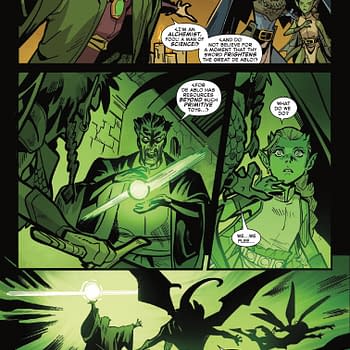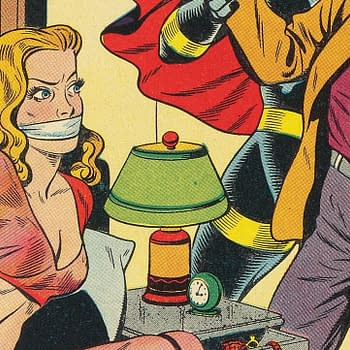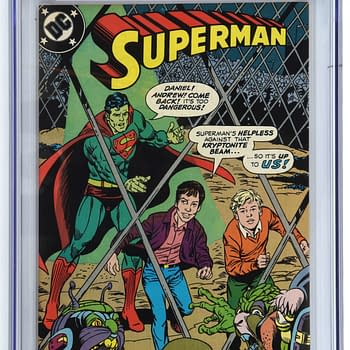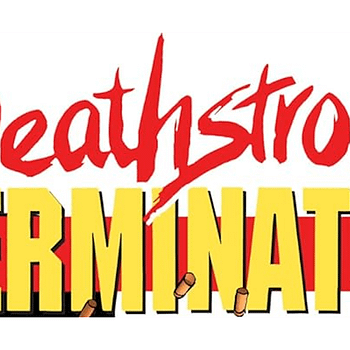Posted in: Comics, san diego comic con | Tagged: Comics, entertainment, Marvel Comics, san diego comic con, Skottie Young
SDCC '15: Spotlight On Skottie Young – 'Instead Of Playing With The Toy, I'd Try To Draw It'

Asked whether when he was a young child, he had comics aspirations, Young said that a 6 year old shouldn't be thinking about jobs, to laughter. He was into drawing stories and making jokes with drawings via an interest in Mad Magazine.
Asked if he has a sense of humor that's inborn or learned, he said that if you visit with his family, you'll hear lots of "bad words" and a wide range of everyone "busting eachothers" butts (implied). He pointed out that pop culture in the 80's was aimed at humor and Beetlejuice and Peewee Hermann were a big deal. He may have watched Beetlejuice 200 times, he said.

He recalls receiving a brown box with a stack of comics as part of a "grab bag" of comics. He joked that it was probably the extras from a newstand being sent back. There were Alf comics, Captain America, and an issue of Daredevil with Typhoid Mary killing Daredevil. Even when he got those, he didn't realize there were continuities before and afterward for each issue. He got some Archie comics from a garage sale via his grandmother. At the same time as Mad Magazine, there were Garbage Pail Kids that had an element of storytelling.
He was "so in love" with the comic and the product, he said, that he didn't analyze it further. He was in high school before he started following certain creators. When Image Comics started, that's around the time he found his first real comic book shop. Speaking of jobs that he had as a kid and young person, he joked about the craziness of letting young children be paper boys and working at Big Lots drawing ads where at 15 or 16 years old he smoked and lived it up in his own backroom office.
He bought a pack of blueline paper at age 18, and at 30 dollars, it seemed really expensive. He had the paper for years because he felt intimidated by its expense so never got started. It wasn't until somewhere "deep" in his "career" that he learned the difference between "illustrating" and "cartooning". Cartooning can use a single image, he said, but he was mostly drawing and not telling stories early on. His "style" is a collection of "abilities" for him, things that people discover over time.
He did a series of The Human Torch, a "real interesting run", for him, since his art would sometimes change "in the middle of an issue" and certainly from issue to issue. When in his 20's, he started being called a "superstar", he didn't know what to make of it. He said, to applause that he's not a "faux humble person" and said, "I think I'm awesome". But on the Human Torch series, he was very frustrated. He was "reach way outside" of his boundaries, he said. Around 2005 and 2006, he started getting jobs helping develop shows for Warner Bros. and the Cartoon Network. He'd do character drawings, background, and develop the show. But a lot of that work never gets seen, though the money is good. It got him thinking about drawing "in a different way", drawing for animation. Most of his job dealt with "erasIng" and removing things from his own work. He started leaving out crosshatching and "hiding behind areas of black". It made him think about "shape, mass, and movement". It "opened his eyes" a bit.

Moving onto the big subject of the Marvel Comics "baby" covers, he recently finished an Ant-Man cover that's #100 of the covers he's done and he's done about 30 since then. On his calendar, there's a new title or two every Monday. Asked who he most likes to draw in that style, he said Cyclops is a big one. He loves the visor, and it's long rectangular shape. He likes coming up with "eye puns" for him too.
Rocket Racoon was a series with "nice timing". Two years before the book came out, he had a CV and was wondering what he'd do next. He wanted to write and draw his own material with humor characters. At the time, Guardians of the Galaxy was in very early stages, but hadn't had trailers yet etc and the public weren't into the idea. He knew about Rocket Racoon in the film and suggested that or Deadpool. The first issue came out the week the moving came out, in the end, which was tight timing. Young said the series wasn't nerve-wracking working on it, but when he saw the popularity from the film, it was. People assume that if you're an artist, you can't also write. He commented that this is strange since there's aren't qualifications to make you a writer. He felt people already sighed, thinking, "oh an artist writing", but pointed out how many scripts he'd looked at over the years. He knew that the "next stage of this" needed to be him writing it himself.
Now there'll be I Hate Fairyland from Image Comics, listed in next month's Previews. When he first started thinking about the market and what would work, was around the time his son (now 5 1/2) was one year old, he got the idea for that book. Having to read the same book over and over again to his son just got on his nerves as well as the same animated shows. Because he felt that way, it occurred to him that Fairyland would not appeal to a child who grew up, stuck there for 30 years. Still appearing as a 6 year old, with rotten teeth from the sugary world, she would hate that place, he laughed. He took Lobo and Tank Girl, and shoved it into the head of this child, then put an axe in her hand and sent her off to "sugar land", he said.















